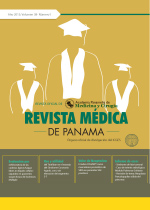Diagnóstico de la Enfermedad Renal Crónica y Factores de Riesgo Asociados en Áreas Seleccionadas de la Provincia de Coclé, Panamá.
Autores/as
DOI:
https://doi.org/10.37980/im.journal.rmdp.2014159Resumen
En los últimos años, las enfermedades crónicas no transmisibles, como el cáncer, diabetes mellitus, enfermedad cardiovascular o Enfermedad Renal Crónica (ERC), han sido las responsables de más del 60% de la mortalidad adulta en el mundo, valor que puede superar el 80% en los países en vías de desarrollo. A nivel global, tanto la incidencia como la prevalencia de la ERC se han incrementado de forma paulatina en los últimos años. Latinoamérica en su conjunto, y Panamá como país, no son excepciones a esta tendencia. El presente estudio está dirigido a diagnosticar la prevalencia de la ERC y sus factores de riesgo asociados en poblaciones de la provincia panameña de Coclé, en las que la prevalencia de pacientes en diálisis está muy por encima del promedio nacional (poblaciones de Puerto el Gago y Juan Díaz), comparados con una población control (Churuquita Grande). Se realizó un muestreo aleatorio que incluyó pacientes entre 18 y 75 años, distribuidos al azar en diversos sectores, que aceptaron participar en el estudio. Se evaluaron diversos parámetros demográficos, clínicos y de laboratorio. Los resultados confirmaron una mayor prevalencia de la ERC en las dos poblaciones seleccionadas respecto de la población control, pero no se encontraron diferencias significativas en la prevalencia de los dos principales factores de riesgo, diabetes e hipertensión. Estos resultados podrían sugerir causas medioambientales y/o riesgos ocupacionales como las razones subyacentes de los mayores índices de ERC en esta provincia panameña.
Diagnosis of Chronic Kidney Disease and Associated Risk Factors in Selected Areas of the Province of Cocle, Panama.
Abstract
In recent years, non-communicable chronic diseases, such as cancer, diabetes mellitus, cardiovascular disease or chronic kidney disease (CKD), have been responsible for more than 60% of adult mortality in the world; value can exceed 80% in developing countries. At the global level, both the incidence and the prevalence of the ERC have increased gradually in recent years. Latin America as a whole, and Panama as a country, are not exceptions to this trend. The present study is aimed at diagnosing the prevalence of CKD and their associated risk factors in populations of the Panamanian province of Coclé, in which the prevalence of patients on dialysis is well above the national average (port stocks the Gago and Juan Díaz), compared to a population control (Churuquita Gran In recent years, non-communicable chronic diseases, such as cancer, diabetes mellitus, cardiovascular disease or chronic kidney disease (CKD), have been responsible for more than 60% of adult mortality in the world, value can exceed 80% in developing countries. At the global level, both the incidence and the prevalence of the ERC have increased gradually in recent years. Latin America as a whole, and Panama as a country, are not exceptions to this trend. The present study is aimed at diagnosing the prevalence of CKD and their associated risk factors in populations of the Panamanian province of Coclé, in which the prevalence of patients on dialysis is well above the national average (port stocks the Gago and Juan Díaz), compared to a population control (Churuquita Grande). He was a random sampling conducted in patients between 18 and 75 years, distributed randomly in various sectors that have agreed to participate in the study. Various demographic, clinical and laboratory parameters were evaluated. Results confirmed a higher prevalence of the ERC in the two populations selected with respect to population control, but there were significant differences in the prevalence of the two main factors of risk, diabetes and hypertension. These results may suggest causes environmental and/or occupational risks as the underlying reasons for the highest rates of ERC in this Panamanian province.
Key Word: Chronic kidney disease, prevalence, diagnosis, risk factors, Panama.
Publicado
Número
Sección
Licencia
Derechos autoriales y de reproducibilidad. La Revista Médica de Panama es un ente académico, sin fines de lucro, que forma parte de la Academia Panameña de Medicina y Cirugía. Sus publicaciones son de tipo acceso gratuito de su contenido para uso individual y académico, sin restricción. Los derechos autoriales de cada artículo son retenidos por sus autores. Al Publicar en la Revista, el autor otorga Licencia permanente, exclusiva, e irrevocable a la Sociedad para la edición del manuscrito, y otorga a la empresa editorial, Infomedic International Licencia de uso de distribución, indexación y comercial exclusiva, permanente e irrevocable de su contenido y para la generación de productos y servicios derivados del mismo. En caso que el autor obtenga la licencia CC BY, el artículo y sus derivados son de libre acceso y distribución.






